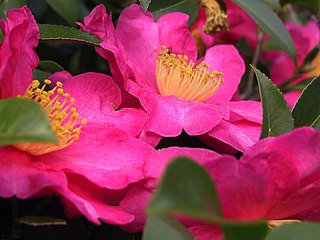
Camellia is a genus of flowering plants in the family Theaceae. They are found in tropical and subtropical areas in eastern and southern Asia, from the Himalayas east to Japan and Indonesia. There are more than 220 described species. Camellias are popular ornamental, tea and woody-oil plants that have been cultivated throughout the world for centuries. To date, over 26,000 cultivars, with more than 51,000 cultivar names including synonyms, have been registered or published.

Camellia sinensis is a species of evergreen shrub or small tree in the flowering plant family Theaceae. Its leaves, leaf buds, and stems can be used to produce tea. Common names include tea plant, tea shrub, and tea tree.

Pumpkin seed oil is a culinary oil, used especially in eastern Europe.
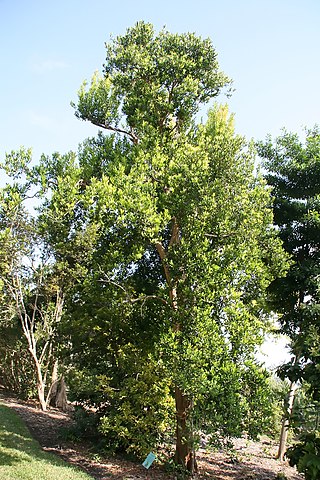
Pimenta racemosa is a species of plant in the myrtle family (Myrtaceae) that is native to the Caribbean region. Common names include West Indian bay tree, bay rum tree, and ciliment.
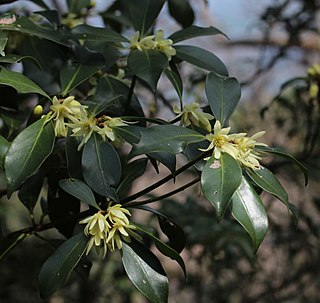
Illicium anisatum, with common names Japanese star anise, Aniseed tree, and sacred Anise tree, known in Japan as shikimi, is a tree closely related to the Chinese star anise. Since it is highly toxic, the fruit is not edible; instead, the dried and powdered leaves are burned as incense in Japan. Its branches and evergreen leaves are considered highly sacred by Japanese Buddhists due to aversion from insects and their ability to remain fresh after pruning.

Tea seed oil is an edible plant oil. It is obtained from the seeds of Camellia oleifera.

Behenic acid is a carboxylic acid, the saturated fatty acid with formula C21H43COOH. In appearance, it consists of white solid although impure samples appear yellowish.

Moringa oleifera is a fast-growing, drought-resistant tree of the family Moringaceae, native to the Indian subcontinent and used extensively in South and Southeast Asia. Common names include moringa, drumstick tree, horseradish tree, or malunggay.
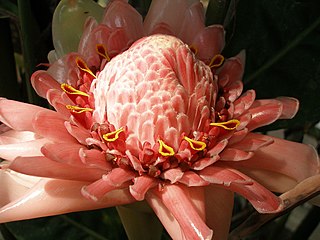
Etlingera elatior is a species of herbaceous perennial plant in the family Zingiberaceae; it is native to Indonesia, Thailand, Malaysia and New Guinea.

Lithospermum arvense, known as field gromwell, corn gromwell, bastard alkanet, and stone seed, is a flowering plant of the family Boraginaceae. It is native to Europe and Asia, as far north as Korea, Japan and Russia, and as far south as Afghanistan and northern Pakistan. [1] It is known in other places as an introduced species, including much of North America and Australia. [2],[3] The European Union has granted the refined oil of the seed of Buglossoides arvensis novel food status and some farmers are growing it [4] commercially in the United Kingdom as a plant-variety patented (PVP) and trademarked cultivar (Ahiflower®). The seed oil contains high levels (63-72%) of omega-3 ALA (c18:3), omega-3 SDA (c18:4), and omega-6 GLA (c18:3)[5] and has GRAS review status from the US Food and Drug Administration, Canadian ingredient master file (IMF) registration and novel food status, and GMP+ Feed Support Product status in the EU for livestock and companion animals. The seed oil also has TGA Australia Complementary Medicines approval status, ANVISA/MAPA Brazil human and animal alimentary use approval, and limited food use approvals in Korea and Japan.

Camellia sasanqua, with common name sasanqua camellia, is a species of Camellia native to southern Japan. It is usually found growing up to an altitude of 900 m (3,000 ft).

Kuding is a particularly bitter-tasting Chinese infusion, which due to their similarities in appearance is derived from several plant species. The two most common plants used to make kuding are the wax tree species Ligustrum robustum and the holly species Ilex kaushue, the former being more commonly grown in Sichuan and Japan while the latter is most commonly grown and used in the rest of China. Tea produced from Ligustrum or many species of Ilex is caffeine-free, although not Ilex paraguariensis, the source of mate drank in South America.
Rose hip seed oil is a pressed seed oil, extracted from the seeds of the wild rose bush Rosa rubiginosa in the southern Andes. Rosehip seed oil can also be extracted from Rosa canina, a wild rose species native to Europe, northwest Africa, and western Asia. The fruits of the rosehip have been used in folk medicine for a long time. Rosehips have prophylactic and therapeutic actions against the common cold, infectious diseases, gastrointestinal disorders, urinary tract diseases, and inflammatory diseases.

Heliotropium arboreum is a species of flowering plant in the borage family, Boraginaceae. It is native to tropical Asia including southern China, Madagascar, northern Australia, and most of the atolls and high islands of Micronesia and Polynesia. Common names include velvetleaf soldierbush, tree heliotrope, veloutier, and octopus bush. It is a shrub or small tree typical of littoral zones reaching a height of 3.6 m (12 ft), with a spread of about 5 m (16 ft).
Malania oleifera is a species of plant in the Olacaceae family, the only species in the genus Malania. It is a medium-sized tree, 10–20 metres (33–66 ft) tall, that is endemic to southern China where it can be found in Western Guangxi and South-Eastern Yunnan provinces. Known as "garlic-fruit tree" or ‘suantouguo’ (蒜头果) by local communities due to its garlic-shaped fruits, it is threatened by logging and habitat loss. Notable for its substantial phytochemical value, its seed has the highest-known proportion of nervonic acid (C24H46O2, PubChem CID: 5281120). Nervonic acid is an important component in myelin biosynthesis in the central and peripheral nervous system, and has been proposed to enhance human brain function. To aid this research its 1.51 Gigabase genome has been sequenced by researchers in China.

Nervonic acid is a fatty acid. It is a monounsaturated analog of lignoceric acid (24:0). It is also known as selacholeic acid and cis-15-tetracosenoic acid. Its name derives from the Latin word nervus, meaning nerve or sinew.

Cooking oil is a plant or animal liquid fat used in frying, baking, and other types of cooking. Oil allows higher cooking temperatures than water, making cooking faster and more flavorful, while likewise distributing heat, reducing burning and uneven cooking. It sometimes imparts its own flavor. Cooking oil is also used in food preparation and flavoring not involving heat, such as salad dressings and bread dips.
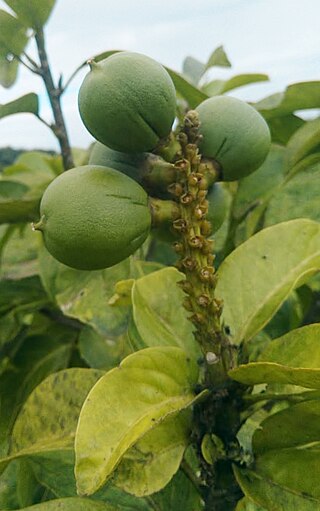
Caryodendron orinocense, commonly known as cacay, inchi or orinoconut, is an evergreen tree belonging to the family Euphorbiaceae.

















